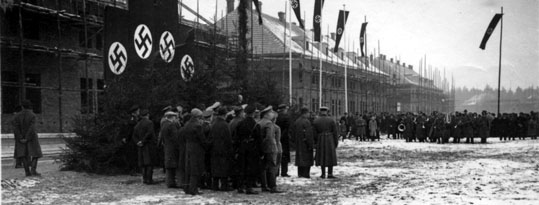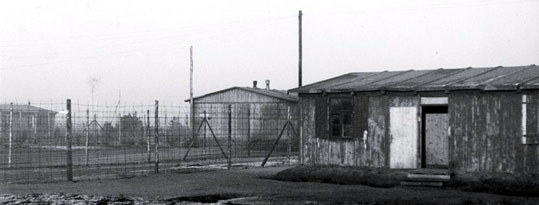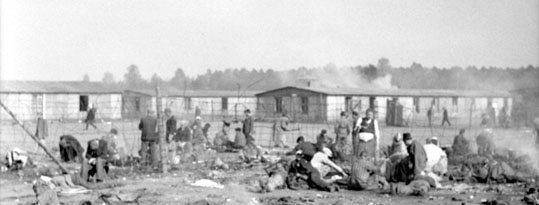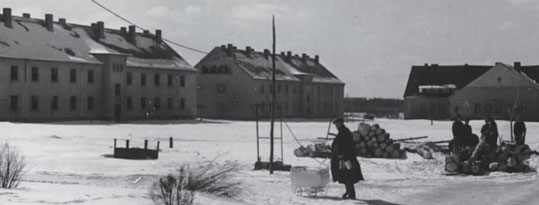History Bergen Belsen
After the outbreak of World War II, the Wehrmacht set up a camp for Belgian and French prisoners of war in huts at the edge of the Bergen Military Training Area. The camp was significantly expanded in the spring of 1941. Following the German invasion of the Soviet Union, over 21,000 Soviet POWs were deported to the camp until the autumn of 1941. Between July 1941 and April 1942, 14,000 Soviet POWs died there of starvation, disease and exposure.
In April 1943, the SS took over the southern section of the camp and turned it into an “exchange camp” for Jewish prisoners. The SS decided in the spring of 1944 to also use the camp for other purposes and additional groups of prisoners. This dramatically changed the character of the camp, the structure of the prisoner society and, above all, the prisoners’ living conditions. When the Bergen-Belsen concentration camp was liberated on 15 April 1945, British soldiers found thousands of unburied bodies and tens of thousands of severely ill prisoners.
A total of 52,000 prisoners from all over Europe were killed in the Bergen-Belsen concentration camp or died immediately after its liberation as a result of their imprisonment.
After the liberation, the British Army set up an emergency hospital at the nearby Wehrmacht barracks which developed into a camp for Polish and Jewish displaced persons (DPs). This was the largest Jewish DP camp in Germany, at times holding up to 12,000 survivors of the Shoah. The DP camp was closed in 1950.
Chronology
-
1935-1943
1935-1943
1935-1937
Not far from the new military training base Belsen, a barrack camp is used as a residential settlement for civil construction workers who build the barracks complex of the troops' camp.
June 1940
The Wehrmacht takes over that camp of huts located around two kilometres south of the Belsen military base and uses it to house 600 French and Belgian POWs.
May/June 1941
The camp is expanded to form a Stammlager (“base camp”) and hospital for Soviet POWs. It is named Stalag XI C (311) Bergen-Belsen.
July 1941
The first transport arrives with 2,000 Soviet POWs. More than 21,000 POWs from the Soviet Union arrive by the autumn of 1941. Since very few huts have been completed, they are forced to sleep in the open, in earthwork dens or shelters made from branches.
From August 1941
A Gestapo Einsatzkommando (“task force”) carries out selections among the POWs, and at least 500 Jews and political functionaries are transported to the Sachsenhausen concentration camp and murdered.
Early April 1942
Between July 1941 and April 1942, 14,000 Soviet POWs die of starvation, disease and exposure.
-
1943-1945
1943-1945
April 1943
The Wehrmacht hands over the southern section of the camp to the SS, who establishes an “exchange camp” there. This camp holds Jewish hostages whom the SS intends to exchange for Germans interned abroad. The exchange camp is part of the Nazi concentration camp system.
The POW hospital in the northern part of the camp remains under the control of the Wehrmacht.June 1943
Stalag XI C (311) is disbanded, and the hospital for POWs becomes a branch camp of Stalag XI B at Fallingbostel.
July 1943
More than 2,300 Polish Jews are transported to the Bergen-Belsen exchange camp. At least 14,600 Jews, most of them from Hungary or the Netherlands, are taken to the camp by the end of 1944.
October 1943
Around 1,800 Polish Jews are transported from Bergen-Belsen to Auschwitz-Birkenau, where they are murdered immediately after their arrival.
From March 1944
A new section is established in the Bergen-Belsen concentration camp. The SS uses this so-called men’s camp to hold thousands of prisoners from other concentration camps who are sick and no longer able to work.
Late June 1944
A transport carrying 222 Jews leaves the Bergen-Belsen exchange camp and heads to Palestine. Around 2,560 exchange camp prisoners are released by April 1945.
Late July 1944
The 500 patients in the hospital for Italian military internees at Fallingbostel-Oerbke, most of whom are suffering from tuberculosis, are transferred to the Bergen-Belsen POW camp.
From August 1944
A new section is set up for female prisoners at the Bergen-Belsen concentration camp. Thousands of women arrive, primarily from Auschwitz. Most of them are transported on to other concentration camps or to three satellite camps of Bergen-Belsen to perform forced labour.
October/November 1944
After the Warsaw Uprising is quelled, 1,000 soldiers and officers from the Polish Home Army, half of them women, are taken to Bergen-Belsen as POWs.
Earlier in August of the same year, several thousand civilian women and children who had been involved in the Warsaw Uprising were taken to the women’s camp at Bergen-Belsen.December 1944
SS-Hauptsturmführer Josef Kramer, former commandant of the Auschwitz-Birkenau extermination camp, is appointed commandant of the Bergen-Belsen concentration camp.
From December 1944
The concentration camps near the front lines are evacuated and at least 85,000 prisoners are transported to Bergen-Belsen by mid-April 1945.
January 1945
The Bergen-Belsen POW camp is disbanded after its prisoners are transferred to other POW camps.
-
1945-1950
1945-1950
15 April 1945
British troops liberate around 53,000 prisoners at Bergen-Belsen. From 1943 to 1945, at least 52,000 women, men and children died in the Bergen-Belsen concentration camp or of the immediate effects of their imprisonment. At least 19,700 people died in the Bergen-Belsen POW camp from 1940 to 1945.
April/May 1945
More than 20,000 victims of the Bergen-Belsen concentration camp are buried in mass graves. Nearly 29,000 survivors are transferred from the camp to an emergency hospital set up by the British in the nearby Wehrmacht barracks. The survivors are given the status of displaced persons (DPs).
To prevent the spread of disease, the British burn down most the wooden huts in the grounds of the former concentration camp.June to October 1945
The emergency hospital is turned into a displaced persons camp, which is soon divided into separate sections for Polish and Jewish DPs.
September to November 1945
The first Belsen Trial is held before a British military tribunal in Lüneburg.
September 1945
The First Congress of Liberated Jews in the British Zone takes place in the Bergen-Belsen DP camp. To begin with, a wooden monument to the Jewish victims is erected in the grounds of the camp.
October 1945
The commander of the British military government demands that plans be drawn up for an appropriate memorial at the site of the former camp.
Until autumn 1945
Most the displaced persons from northern, western and southern Europe are repatriated. Soviet survivors are forced to return to the Soviet Union.
November 1945
Polish survivors dedicate a large wooden cross in the grounds of the former concentration camp to commemorate the victims.
The Soviet military mission orders a monument to be erected in the Bergen-Belsen POW cemetery.Early March 1946
The United Nations Relief & Rehabilitation Administration (UNRRA) takes over administration of the DP camp from the British Army. The Central Committee of Liberated Jews in the British Zone is the self-governing organisation for Jewish DPs based in the DP camp.
April 1946
Jewish survivors unveil a stone monument on the site of the provisional wooden monument.
June to September 1946
The Polish DPs are transferred and the Polish DP camp is disbanded. Bergen-Belsen subsequently becomes the largest Jewish DP camp in post-war Germany.
1946 to 1952
Part of the grounds of the former camp are turned into a memorial, and an international monument is erected.
From 1948
Once the State of Israel is founded and the USA and other countries have eased their immigration restrictions, most of the Jewish DPs are able to emigrate from Germany.
May to July 1950
The Bergen-Belsen DP camp is disbanded and its remaining inhabitants are transferred to Upjever.
-
1950-today
1950-today
November 1952
The Bergen-Belsen Memorial is inaugurated and handed over to the state of Lower Saxony.
1960 to 1961
Extensive landscaping is carried out in the Memorial grounds.
1964 to 1968
The Bergen-Belsen POW cemetery is comprehensively redesigned.
April 1966
The first Document Building opens with an exhibition on the history of the Bergen-Belsen concentration camp.
April 1990
A new permanent exhibition opens in the expanded Document Building at the Bergen-Belsen Memorial.
October 2007
The new Documentation Centre of the Bergen-Belsen Memorial opens. It contains a permanent exhibition covering the POW camps on Lüneburg Heath, the Bergen-Belsen concentration camp and the DP camp.
2009
Start of institutional support of the Bergen-Belsen memorial by the Federal Republic of Germany.
Juni 2012
Additional clearings in the vegetation mark the entire perimeter and individual sections of the camp. In the course of this landscaping, pillars located at historically significant sites throughout the ground and nine additional relief models provide visitors with topographical and historical information about the site.







